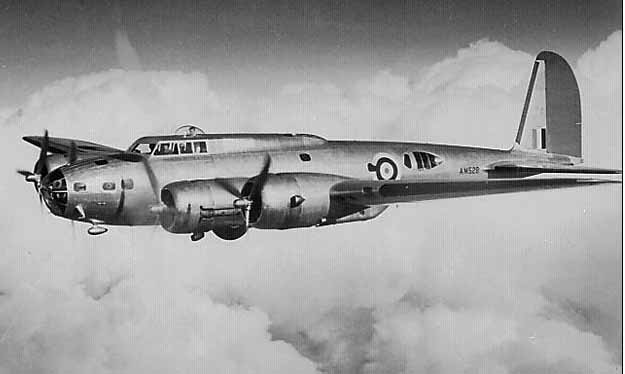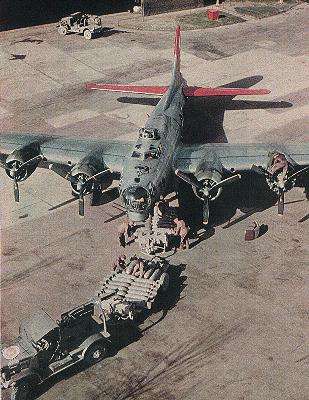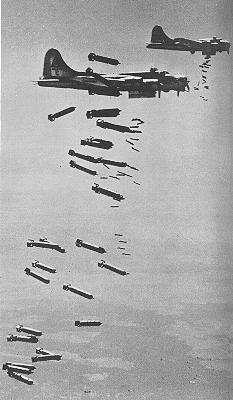 |
|||
|---|---|---|---|
| |
| ||
 |
|||
|
The Boeing B-17F "Flying Fortress." This aircraft lacks the "chin" turret, which was standard on the B-17G.
|
|||
|
The Boeing B-17, and the Consolidated B-24 were the United States' two standard heavy bombers until
the introduction of the
B-29 Superfortress. B-17s were flown by the United States Army Air Corps (USAAC), throughout the American participation in the Second World War. They were used by the US Eighth Air Force, based in the UK, to bombard German targets in Europe during daylight hours, a method which resulted initially in very heavy losses of aircraft and crew. As B-17 refinements progressed, along with better pilot training and tactics, it would become a formidable adversary in the Allied war against Germany.
The Flying Fortress was designed for a USAAC competition, announced in 1934, to find a modern replacement for the assorted Keystone biplane bombers, then in service.1 The requirement was for a multi-engined bomber to be used mostly as a coastal-defense aircraft. Specifications required were: a range of at least 1,020 miles (1,641 km), but preferably 2,200 miles (3,540 km); a speed of at least 200 mph (322 km/h), but preferably 250 mph (402 km/h); a capability of carrying a 2,000 lb (907 kg) bomb load.2 A Boeing design team began work on the Model 299 prototype in June 1934, and construction began in August of the same year. (The most significant rival to the Model 299 was the Douglas DB-1, which later developed into the Douglas B-18 Bolo.) The Model 299 was make-or-break gamble for Boeing,3 which first flew on July 28,1935, and eventually won the competition. Boeing built a few preproduction Y1B-17s (later redesignated B-17As), followed by one Y1B-17A, and then followed by thirty-nine B-17Bs. Since funding was lacking at the time, only thirty Flying Fortresses were fully operational when Hitler's forces invaded Poland in September 1939.4 The US was not involved in the fighting in Europe at the time, so it did not seem to be a matter of urgency. However, as it became clearer that US involvement was inevitable, after the Munich Crisis,5 orders for B-17s were increased. Thirty-eight B-17Cs and forty-two B-17Ds were built before the first large production run began with the B-17E variant. Twenty B-17Cs were delivered to the RAF as Fortress Is, which quickly showed that defensive armament was inadequate, (the B-17C carried seven 50-cal. machine-guns) and at high altitude raids of 30,000 ft. (9,144 m), the defensive guns froze up, when they tried to fire them. Also bombs raids at high altitudes proved to be very inaccurate, and most of the bombs were missing their targets. The airplane was revised as the Model 299O, with the most important changes incorporated into the Model 299H (B-17C and B-17D).6 Modifications included self-sealing tanks and additional armor for crew protection. |
 |
|---|
| Above is a Boeing B-17C, Fortress I, RAF No. AN529. Later versions, starting with the B-17E, incorporated a dorsal fin on the fuselage, with a sturdier vertical stabilizer and rudder. |
|
In September of 1941, the B-17E appeared with an extensively modified empennage. Gone was the pert fin and rudder riding precariously behind the stabilizer. Instead, a broad yet graceful dorsal fin rose from amidships. Aesthetically, the B-17E was a retrograde step, but more importantly, it would turn a relative failure, into an outstanding military success. The B-17E enveloped a deadly stinger of twin .50-cal. machine guns, and a remote controlled belly turret held two more .50s. One hundred-twelve B-17Es were built, followed by four hundred more, with a manned Sperry ball turret replacing the remote system. The B-17E was lengthened to 73 feet 10 inches (22.5 m) to accommodate the new defensive tail position. Top speed was 317 mph (510 km/h), cruising at over 200 mph (321 km/h) with 4,000 lb (1814 kg) of bombs. The crew was increased from nine to ten members. The additional equipment made the aircraft seven tons heavier than the original Model 299.7
The Pearl Harbor attack of December 7,1941 finally brought the United States into the war and production of the B-17 rapidly increased. By July 1942, the US began forming the Eighth Air Force in Britain, equipped with B-17Es. The 'E' represented an important improvement over the earlier B-17s, in that it had a tail turret, eliminating a previous defensive blind spot. Production of the B-17F was undertaken by Douglas and Vega, a subsidiary of the Lockheed Aircraft Corp., but modifications were taking their toll in airspeed. There were more than four hundred modifications on the B-17F.8 The B-17F, now armed with eleven .50-cal. guns, could only reach 299 mph (481 km/h), but landing speed was up to 90 mph (144 km/h)! Service ceiling was 37,500 ft. (11,430 m) and range 2,880 miles (4,634 km). It took twenty-five and a half minutes to climb to 20,000 ft. (6,096 m). Three thousand, four hundred B-17Fs were produced by the three companies. |
 |
|---|
| Boeing B-17 cockpit controls. |
| On August 17,1942, United States B-17s carried out a bombing raid on the railway yards at Rouen in France. The real offensive, however, started on January 27,1943, when B-17s of the USAAF made their first attacks on Germany. Initially, casualties were very high because they attacked during daylight hours to achieve greater accuracy, and because proper formation flying (to enable a group of airplanes to defend each other with crossfire) had not yet been formulated. Also the B-17F lacked adequate defense against a head-on attack. By September 1943, the Flying Fortress showed its final shape during firepower tests on the XB-40, a modified B-17F with the advantage of a "chin" turret. The success of the chin turret, led to the delivery of the B-17G (the major production version), which was the first production variant to have a chin turret installed, under the nose. The Bendix turret held two .50-cal. guns, which increased the armament to thirteen guns.9 In all, there were 8,680 B-17Gs built by Boeing, Vega, and Douglas to make this the largest production variation. Produced in greater numbers than any other single model, more B-17Gs were lost, than any other model.10 B-17G specifications included a span of 103 feet 9 inches (31.6 m), length of 74 feet 4 inches (22.6 m), and a height of 19 feet 1 inch (5.8 m). The four supercharged Wright R-1820-97 Cyclones delivered 1,200 hp (895 kW) and gave a top speed of 287 mph (462 km/h), cruising at 182 mph (293 km/h). Service ceiling was 35,800 ft. (10,850 m), with a max. range of 3,400 miles (5,471 km). Empty and gross weights were 36,135 lb (16,390 kg)and 65,500 lb (29,710 kg). Maximum fuel load was 3,630 gallons (13,741 liters). |
 |
|---|
| The B-17G introduced new fire power in the form of the Bendix chin turret. |
|
On 19 July 1943, US B-17s and
B-24 Liberators carried out the first bombing raid on Rome. US bombing in Europe reached its high point in February 1945 with a 1,000-bomber raid on Berlin, escorted by 400 fighters, and the Dresden raid (alongside RAF Lancasters) which, caused a massive fire storm to sweep the city. Meanwhile, B-17s were also helping to win the war against Japan, although by mid-1943 the larger Boeing B-29 had begun to take over the major strategic bombing missions in the Pacific theater.
Following the first Model 299, the Air Corps purchased 12,725 B-17 type aircraft, of which a few served with Royal Air Force Coastal Command and the United States Navy for patrol, air-sea rescue, antisubmarine and other duties. Cargo conversions of the B-17 were known as the XC-108. |
|
 |
 |
|---|---|
| A B-17 being loaded at an English base with three-hundred pound bombs. | In June 1944, the Americans dropped 120,000 tons of bombs on Germany. |
|
More auspicious was a raid on August 17, against the railroad yards at Rouen. A dozen B-17 Flying Fortresses loaded with three hundred-pound bombs, completed their mission without losses. In the fall, the North African invasion diverted planes and men and temporarily stalled the buildup of US air strength in England. But as the Eighth continued to stab at the enemy, American crews matched the courage and ability of veterans.
On one occasion, for instance, nine B-17s, turning back from a canceled mission against Rotterdam, were jumped by more than twenty German fighters. The Americans fought their way back to England, but in one bomber the pilot was injured and the copilot killed. The bombardier, who had been washed out of flying school, took over the controls and flew the plane back home on two engines. |
A Luftwaffe Test Pilot's Account of a Captured B-17Luftwaffe Test Pilot by Hans Werner LerchePerhaps there were other aircraft that were even more pleasant to fly than the B-17, because it did have its drawbacks: for example, the forces acting on the ailerons were relatively high, and the rudder felt as if it were set in concrete. But it was much more important that the aircraft was easy to fly and land. When one had become accustomed to the higher all-up weight and the strange instruments, it could be compared with our He 111 in the degree of effort needed to fly it. What was really outstanding about the B-17, which made it, together with the Liberator, the standard day heavy bomber in the European theater of war? It certainly was not fast in low altitudes; only the exhaust-driven turbosuperchargers gave the B-17 its good performance at higher altitudes. All in all, that was for me the most admirable thing about American planning, namely the consequential pursuit of a concept once it had been recognized as correct, in this case the effectiveness of raids, carried out by well-armed high-altitude bombers flying in close formations. One must remember that several years would pass between planning and execution of a concept. Possibly only the idea of keeping the attacking fighters at bay with heavily armed bombers flying in close formation and firing from all 'portholes' had to be revised. This consequently happened after the raid on Schweinfurt, which due to the long distance involved, had to be carried out without fighter escort, During this raid the USAAF bombers suffered heavy losses from twin-engined Zerstorer and single-seat fighters attacking with rocket missiles, which naturally caused quite a crisis. The correct solution to this problem was soon found: elimination of the sluggish, rocket-carrying Luftwaffe 'destroyers' by escort fighters -- and several versions of these, with excellent performance, were also soon available. Nor did the rather poorly adjusted control forces on the American bombers have much detrimental effect, as this was certainly not decisive during the approach at great height, and even less so after the bombers had been equipped with an excellent three-dimensional autopilot. It must be stressed that the respectable speed of the B-17 at higher altitudes was due solely to its excellent exhaust-driven turbo-superchargers. But for the production of these devices, one required not only the know-how, but also large quantities of heat-resisting materials, which we were lacking in Germany. Occasionally I would receive via Switzerland foreign reports on German aircraft, and it was interesting to read that they quite often not only praised the construction of the machines, but the engines as well, more often than not concluding that the Germans just did not have the necessary heat-resistant metals for even better performance. |
| Boeing B-17G Flying Fortress | |
|---|---|
| Dimensions: | |
| Wing span: | 103 ft. 9 in (31.6 m) |
| Length: | 74 ft. 4 in (22.6 m) |
| Height: | 19 ft. 1 in (5.8 m) |
| Wing Area: | 1,420 sq ft (132 sq m) |
| Weights: | |
| Empty: | 36,135 lb (16,391 kg) |
| Normal Loaded: | 49,500 lb (22,475 kg) |
| Maximum Take-off: | 65,500 lb (29,710 kg) |
| Performance: | |
| Maximum Speed: | 287 mph (462 km/h) at 25,000 ft (7,625 m) |
| Cruise Speed: | 182 mph (293 km/h) |
| Service Ceiling: | 35,800 ft (10,850 m) |
| Normal Range: |
2,000 miles (3,219 km) with 6,000 lb (2,722 kg) bomb load @ 220 mph (352 km/h) @ 25,000 ft (7,625 m) |
| Powerplant: | |
| Four 1,200 hp (895 kW) Wright R-1820-97 Cyclones nine cylinder air-cooled single row radial engines. General Electric Type B-22 exhaust driven turbo-superchargers, installed under engine nacelles. | |
| Armament: | |
|
Thirteen 50-cal. machine-guns plus a maximum of 17,600 lb (7,983 kg) of bombs. Normal bomb load 6,000 lbs (2,724 kg). Largest bomb type carried was 2,000 lb (908 kg). | |
Endnotes
|
1. Michael J.H. Taylor and John W.R. Taylor, ed. Encyclopedia of Aircraft. New York; G.P. Putnam's Sons., 1978. 40. 2. Chris Chant. From 1914 To The Present Day, The World's Great Bombers. Edison, NJ; Chartwell Books, Inc., 2005. 90. 3. David Mondey. A Concise Guide to American Aircraft of World War II. New York; Smithmark Publishers, 1996. 20. 4. Ibid. 22. 5. William Green. Famous Bombers of the Second World war. Garden City, New York; Doubleday & Company, 1975. 48. 6. Michael J.H. Walker and John W.R. Taylor, ed. 7. William Green. 53. 8. Ibid. 54. 9. Ibid. 53. 10. Roger A Freeman. Aircraft in Profile, Volume 9; Boeing B-17G Flying Fortress. Berkshire, England; Profile Publications Limited., 1971. 1. |
© The Aviation History On-Line Museum. 2006 All rights reserved.
Updated November 6,2006.